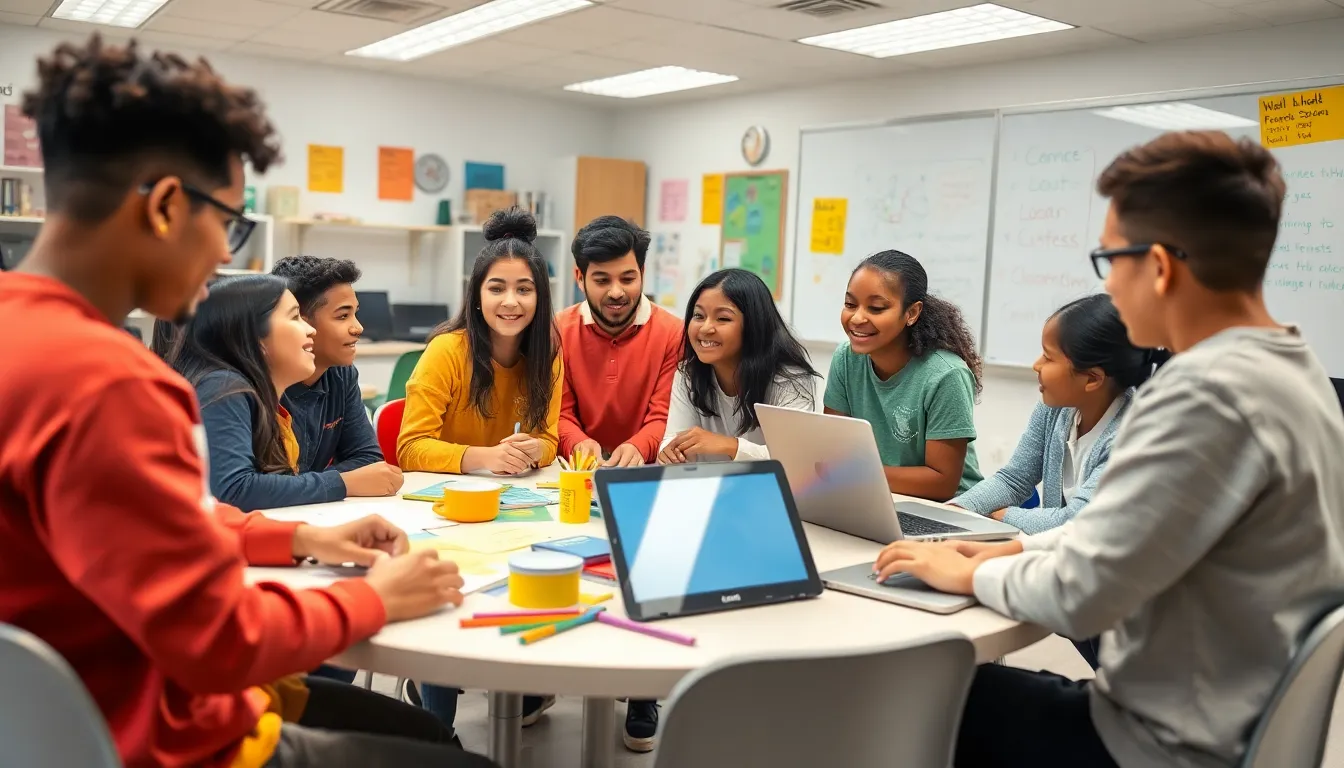In today’s fast-paced world, technology isn’t just a luxury; it’s a necessity—especially in education. Gone are the days of dusty chalkboards and crumpled textbooks. Now, classrooms buzz with the energy of interactive whiteboards, tablets, and virtual reality experiences that make learning feel like a thrilling adventure. Imagine students exploring ancient civilizations through immersive simulations instead of flipping through pages of a textbook.
Table of Contents
ToggleOverview of Technology Used in Education Today
Technology in education enhances engagement and facilitates personalized learning experiences. Interactive whiteboards replace traditional boards, allowing teachers to display multimedia content and collaborate with students. Tablets serve as versatile tools, enabling access to digital textbooks and interactive applications tailored to various learning styles.
Learning management systems (LMS) streamline course management and foster communication between educators and students. These platforms provide centralized access to assignments, grades, and collaborative tools. Virtual reality (VR) provides immersive experiences, transporting students to historical events or scientific phenomena, making complex topics easier to grasp.
Online resources, including educational websites and apps, offer supplemental learning. Students can access tutorials, quizzes, and forums to reinforce their understanding of subjects. Social media platforms, when used appropriately, create communities where learners can share resources and discuss ideas.
Gamification incorporates game elements in educational settings, enhancing motivation and retention. By turning lessons into engaging challenges, students remain enthusiastic about learning. Adaptive learning technologies leverage algorithms to assess individual performance and adapt coursework to meet specific needs.
Data analytics play a crucial role in tracking student progress. Educators can identify struggles and tailor instruction accordingly. Cloud computing enables seamless file storage and sharing, making collaboration easy among students and teachers.
Robotics and coding initiatives foster critical thinking and problem-solving skills. Introducing students to these concepts prepares them for future careers in a technology-driven world. Overall, the integration of diverse technological tools transforms educational practices, creating a dynamic and enriched learning environment.
Types of Technology
Numerous technologies enhance education today. These tools facilitate interactive learning experiences.
Digital Classrooms
Digital classrooms utilize various technological tools to create engaging learning atmospheres. Technologies such as interactive whiteboards allow educators to present dynamic lessons, integrating multimedia resources that capture student attention. Students access course materials through cloud-based storage, promoting collaboration and real-time feedback. Collaborating in digital spaces encourages communication between peers while reducing barriers of distance. This innovative approach transforms the traditional classroom into an interactive environment that fosters creativity and critical thinking.
Online Learning Platforms
Online learning platforms offer flexible educational opportunities accessible from anywhere. Platforms such as Coursera, Udemy, and Khan Academy provide diverse courses for learners of all ages. Students can learn at their own pace, enhancing their understanding of complex subjects through video tutorials and quizzes. Many of these platforms incorporate discussion forums, allowing learners to engage with instructors and fellow students. This increased interaction promotes a sense of community that enriches the online learning experience.
Educational Software and Apps
Educational software and apps cater to various learning needs, offering tailored resources. Applications like Quizlet and Google Classroom streamline study sessions and facilitate communication between educators and students. Students can use these tools to track progress and set personalized goals, enhancing motivation and achievement. Subject-specific software supports interactive learning, making complex topics more comprehensible. By integrating these technologies into curricula, educators create a more effective and engaging learning process.
Benefits of Technology in Education
Technology significantly enhances the educational landscape, amplifying engagement and broadening access to information.
Enhanced Learning Experience
Interactive tools, such as multimedia presentations and virtual reality, facilitate active participation in learning. Students explore concepts through simulations, transforming passive learning into vibrant experiences. Resources like digital textbooks provide instant access to diverse materials. Learning management systems streamline course management, enabling smoother communication between teachers and students. Gamification increases motivation by turning lessons into interactive challenges. As a result, students enjoy a richer and more immersive educational journey.
Accessibility and Inclusivity
Technology fosters inclusivity in education by breaking down barriers. Adaptive learning tools cater to individual learning styles, allowing personalized educational experiences. Online platforms offer resources to students regardless of their location or background, ensuring everyone has equal opportunities. Voice recognition and text-to-speech software support those with disabilities, facilitating their learning process. Students can collaborate through social media and other online forums, promoting diverse perspectives in discussions. These advancements create a more inclusive environment, empowering all learners to succeed.
Challenges and Considerations
Technology’s integration into education presents various challenges that institutions must navigate.
Equity in Access to Technology
Ensuring equity in access to technology remains a critical concern. Many students lack reliable internet and devices, which creates disparities in learning opportunities. Rural and low-income areas face significant barriers, limiting resources and support. Schools often strive to provide access through initiatives like loaner programs and community partnerships. Equity efforts must focus on addressing these gaps, fostering an inclusive environment. Additionally, digital literacy programs can empower students to effectively utilize resources once access is granted. Bridging this gap is vital for ensuring all students can engage fully with modern educational tools.
Teacher Training and Support
Teacher training and support also play essential roles in technology adoption. Many educators require ongoing professional development to effectively implement new tools. Initial training may not address evolving technologies, leaving teachers unprepared. Comprehensive training programs can enhance their confidence and competence. Schools must prioritize continuous support and resources, enabling educators to share best practices. Coaching and collaboration among teachers can cultivate an innovative environment, where technology integration thrives. Promoting a culture of support empowers educators to elevate student engagement and learning outcomes.
Future Trends in Educational Technology
Emerging technologies are set to reshape education further. Artificial intelligence (AI) personalizes learning experiences, adapting them in real-time based on student interactions. Increased use of augmented reality (AR) allows learners to engage with educational content in immersive, interactive ways.
Additionally, blockchain technology offers secure credentialing and certification processes, making verification easier for institutions and employers. Advanced analytics will track learning patterns, providing insights that help educators refine their teaching strategies effectively.
Inclusion of machine learning enhances adaptive learning systems, offering tailored resources to meet diverse student needs. Schools are looking into advanced virtual classrooms that replicate real-world interactions, ensuring students receive a more connected remote learning experience.
Mobile applications are transforming how students access resources, fostering continuous learning outside traditional classrooms. Collaboration tools are gaining traction, allowing students to work together irrespective of geographical barriers.
Gamification remains a driving force in student engagement, turning lessons into rewarding experiences. Social learning platforms encourage peer interactions, further promoting diverse viewpoints and collaborative skills.
Increased emphasis on digital citizenship prepares students for responsible online engagement. Programs focusing on cyber safety and etiquette are becoming essential components of the curriculum.
As technology continues to evolve, educators look to integrate emerging tools and methodologies. Using these innovations can enhance educational outcomes and promote an inclusive environment where all students can thrive.
The integration of technology in education is revolutionizing how students learn and engage with content. By embracing interactive tools and online resources, educators are creating dynamic environments that encourage collaboration and creativity. As advancements like AI and AR continue to emerge, the potential for personalized and immersive learning experiences grows.
While challenges such as access and teacher training remain, schools are taking strides to address these issues. The commitment to fostering digital literacy and equitable access ensures that all students can benefit from these innovations. Ultimately, the ongoing evolution of educational technology promises a brighter future for learners everywhere, empowering them to thrive in an increasingly digital world.




